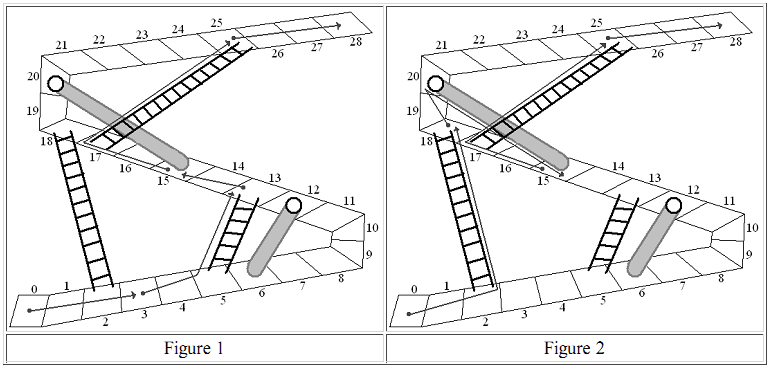当前你的浏览器版本过低,网站已在兼容模式下运行,兼容模式仅提供最小功能支持,网站样式可能显示不正常。
请尽快升级浏览器以体验网站在线编辑、在线运行等功能。
3912:Up and Down
题目描述

This problem is based on a children's game, Chutes and Ladders, where players take turns jumping a number of steps along a path. If they land on the base of a ladder, they rise to the top of the ladder in the same turn. If they land at the top of a chute, they slide down to the bottom in the same turn. The idea is to get to the final step on the path. In the children's game the number of steps to move in a turn is determined randomly, so the game requires no decisions. In the version here, Up and Down, players get to choose the number of steps to jump forward in each turn. Both figures above show spaces numbered from 0 to 28, with several chutes and ladders. They show two different possible sequences of moves, assuming jumps of 1, 2 or 3 are allowed. Each jump is illustrated starting at a gray dot and ending at an arrowhead, jumping 1-3 places ahead, sometimes ending there, and sometimes shifting up a ladder or down a chute. The players in Figures 1 and 2 finish in 5 and 4 turns respectively. Figure 2 demonstrates the minimum number of turns for this path configuration and a maximum jump of 3.
It gets harder a figure out the best path if there are more chutes and ladders and many more spaces along the path! Be careful of your algorithm, given the large limit on the number of spaces specified below.
输入解释
The input will consist of one to twenty data sets, followed by a line containing only 0.
The first line of a dataset contains blank separated integers w s p, where w is the number of the winning space, 3 ≤ w ≤ 1,000,000,000, s is the maximum number of spaces to jump in each turn, 2 ≤ s ≤ 6, and p is the total number of chutes and ladders, 1 ≤ p ≤ 40.
The remaining lines of the data set consist of pairs of integers bi ei, for i = 1, 2, ... p. Each bi ei pair is the beginning space and ending space for a chute or ladder, so a turn with a jump to bi actually ends at ei. All the integers are positive and less than w, and none of these 2p numbers appears more than once. Following the rules of the game, it is possible to eventually reach space w, starting from space 0, for each dataset. The numbers bi are in increasing order. Numbers in these lines are separated by either a single blank or a newline.
The first line of a dataset contains blank separated integers w s p, where w is the number of the winning space, 3 ≤ w ≤ 1,000,000,000, s is the maximum number of spaces to jump in each turn, 2 ≤ s ≤ 6, and p is the total number of chutes and ladders, 1 ≤ p ≤ 40.
The remaining lines of the data set consist of pairs of integers bi ei, for i = 1, 2, ... p. Each bi ei pair is the beginning space and ending space for a chute or ladder, so a turn with a jump to bi actually ends at ei. All the integers are positive and less than w, and none of these 2p numbers appears more than once. Following the rules of the game, it is possible to eventually reach space w, starting from space 0, for each dataset. The numbers bi are in increasing order. Numbers in these lines are separated by either a single blank or a newline.
输出解释
There is one line of output for each data set, containing only the minimum number of turns it takes to start at space 0 and end at space w, with the jump in each turn chosen as a positive integer no larger than s.
The first sample input data set corresponds to the configuration in the Figures.
The first sample input data set corresponds to the configuration in the Figures.
输入样例
28 3 5 2 18 5 13 12 6 17 25 20 15 50 6 1 9 45 0
输出样例
4 3
最后修改于 2020-10-29T07:15:12+00:00 由爬虫自动更新
共提交 0 次
通过率 --%
| 时间上限 | 内存上限 |
| 1000 | 65536 |
登陆或注册以提交代码